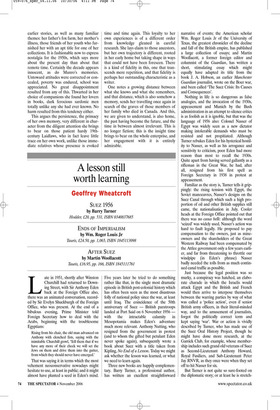This side of the truth
Anita Brookner
THE VIEW FROM CASTLE ROCK by Alice Munro Chatto, £15.99, pp. 349, ISBN 0701179899 ✆ £12.79 (plus £2.45 p&p) 0870 429 6655 In the Foreword she writes to her new book Alice Munro, Canada’s best known and most admired short story writer, states that some 10 or 12 years ago she began to study the history of her family and envisaged a memoir, unlike the fictions which have engaged her all her working life. She was thorough in her researches and unearthed a great deal of material, almost all of it in the Selkirk and Galashiels public libraries. She even spent some months in Scotland, where the Laidlaw branch of her family had its roots. She then attacked the subject but discovered that she was not merely the legatee of her own family but Alice Munro, writer of fiction, whose stories exist in their own right and appear to owe nothing to her ancestry.
In other words in trying to write fact she found that she was writing fiction; each imaginative excursion had its origins in some authentic family detail, and the result is a hybrid of the two genres. More than anything else it is an autobiography of sorts, perhaps the only one she will ever write. The depth of her feelings ensures that she pays loving attention to people she never knew, those hill farmers who sailed for the New World in the early 19th century and of whom little is known, their names being almost their only record.
It has to be said that other people’s remote ancestors, rather like other people’s dreams, are hard to get a grip on, and Munro runs the risk of coming across as merely sentimental. This is in sharp contrast to the delicacy she has always brought to her studies of attachments and misalliances. But, with her reputation assured, she no doubt felt free to indulge her own vagaries, and was perhaps happy to attack one sort of fiction rather than another. Certainly her family forms the basis of such reconstructions as she permits herself, but the material proves insubstantial in comparison with the families she has shaped in her own pages. This is fiction’s advantage over fact: true creativity owes nothing to one’s bloodline but exists in its own right, with its own demands. Influences may play their part but have no bearing on what is in essence an inalienable gift.
There is a marked change of register between the first half of the book, which is entitled ‘No Advantages’, referring to the inhospitable soil of Selkirk parish, and the second, which is simply called ‘Home’. When the chronicle moves forward to the 1940s and 1950s and to Munro’s real memories we rediscover the apparently effortless prose writer we know from earlier stories, as well as many familiar themes: her father’s fox farm, her mother’s illness, those friends of her youth who furnished her with an apt title for one of her collections. It is fashionable now to express nostalgia for the 1950s, which says more about the present day than about that remote time. Certainly the decade appears innocent, as do Munro’s memories. Untoward attitudes were corrected or concealed, poverty was endured, school was appreciated. No great disappointment resulted from any of this. Thwarted in her choice of companions she found her lovers in books, dark ferocious sardonic men totally unlike any she had ever known. No harm resulted from this tendency either.
This argues the persistence, the primacy of her own memory, very different in character from the diligent attention she brings to bear on those patient hardy 19thcentury Laidlaws, who in fact leave little trace on her own work, unlike those immediate relatives whose presence is evoked time and time again. This loyalty to her own experiences is of a different order from knowledge gleaned in careful research. She lays claim to those ancestors, but her own trajectory is different, rooted in her early home but taking shape in ways that could not have been foreseen. There is a kind of fidelity in this, one that transcends mere repetition, and that fidelity is perhaps her outstanding characteristic as a writer.
One notes a growing distance between what she knows and what she remembers, and that distance, which is also somehow a memory, sends her travelling once again in search of the graves of those members of her family who died in Canada. And this, we are given to understand, is also home, the past having become the future, and the time in between almost irrelevant. This is no longer fiction; this is the insight time brings to bear on the whole enterprise, and her engagement with it is entirely admirable.



















































































































 Previous page
Previous page